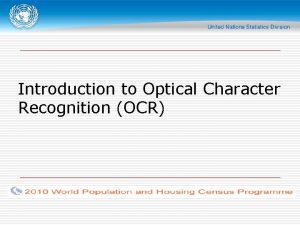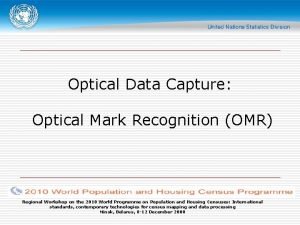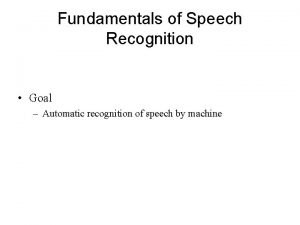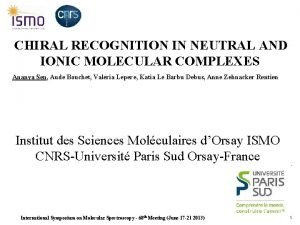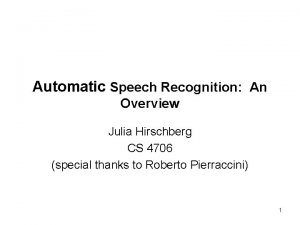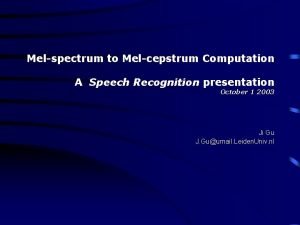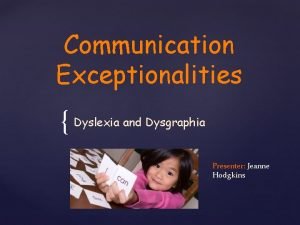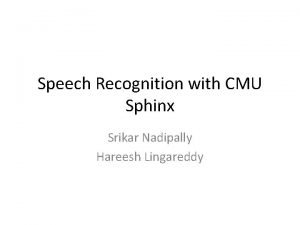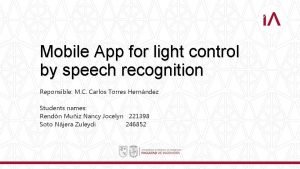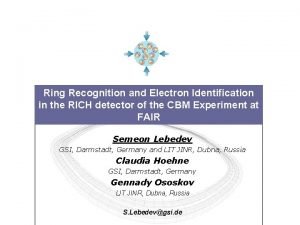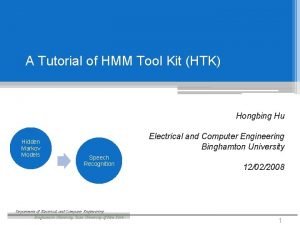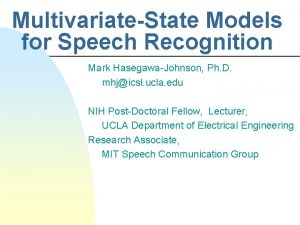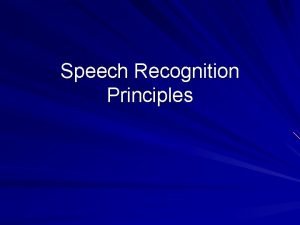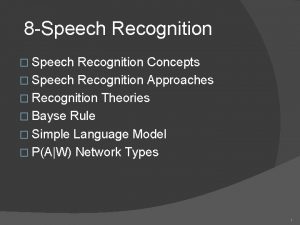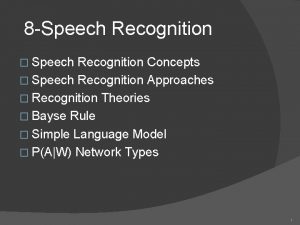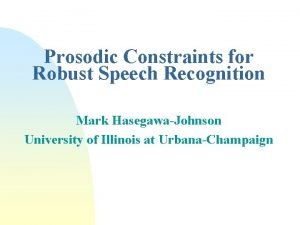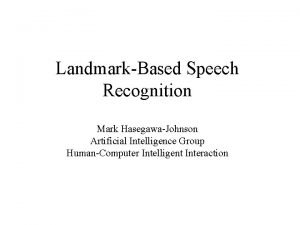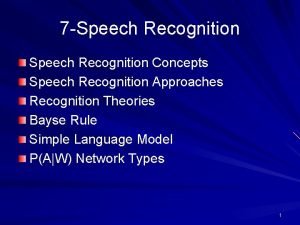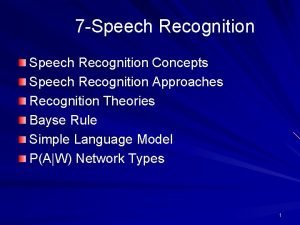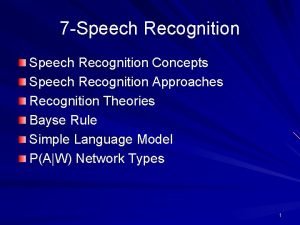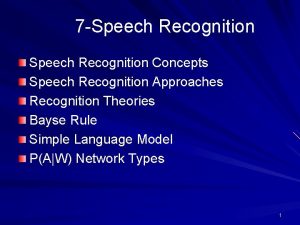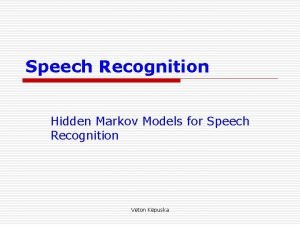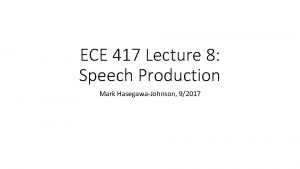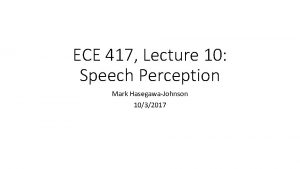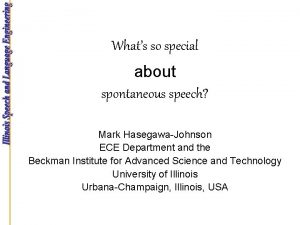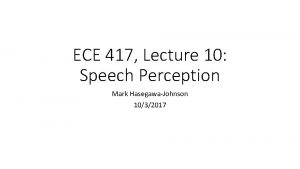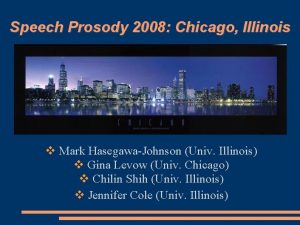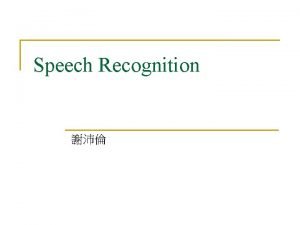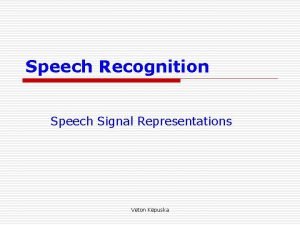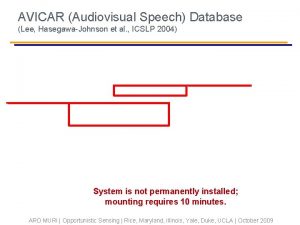MultivariateState Models for Speech Recognition Mark HasegawaJohnson Ph






























- Slides: 30

Multivariate-State Models for Speech Recognition Mark Hasegawa-Johnson, Ph. D. mhj@icsl. ucla. edu NIH Post-Doctoral Fellow, Lecturer, UCLA Department of Electrical Engineering Research Associate, MIT Speech Communication Group

Key Point Speech is a one-dimensional signal which encodes multiple simultaneous partially independent information streams.

Outline Background: Univariate Hidden Markov Models Problem Statement: Multivariate Content of Speech Ex. : Composite Acoustic Cues Multivariate State Models: Definition Complexity Issues Ex. : Composite Acoustic Cues

Background: Statistical Classification Class Definition: Functional Form with Trainable Parameters Training: Modify Parameters of p(obs | class) Create Lookup Table of p(class) Classification: class = argmax p(class | obs)

Hidden Markov Models

HMM Phone Models

HMM Word Models

HMM Sentence Models

Recognition Scoring Find Q to maximize the “Recognition Probability, ” P(O, Q) = p(i) p(o 1|i) p(i|i) p(o 2|i) …

Implementation: the Viterbi Algorithm

Background: Stop Cons. Release n Three “Places of Articulation: ” u Lips (b, p) u Tongue Blade (d, t) u Tongue Body (g, k)

Problem Statement: Content of Speech is Multivariate 1. Source Information: Prosody, Articulatory Features

Content of Speech is Multivariate 2. Useful Non-Source Information: Composite Acoustic Cues

Composite Cues: Traditional Solution

Types of Measurement Error • Small Errors: Spectral Perturbation • Large Errors: Pick the Wrong Peak Amp. (d. B) Frequency (Hertz)

Large Errors are 20% of Total Std Dev of Small Errors = 45 -72 Hz Std Dev of Large Errors = 218 -1330 Hz P(Large Error) = 0. 17 -0. 22 Log PDF Measurement Error (Hertz) re: Manual Transcriptions

Measurement Error Predicts Classification Error

Solution: Composite Cues as State Variables

Complexity of Solution Without Additional Constraints

Useful Constraint #1: State Independence

Useful Constraint #2: Hierarchical Dependence

Description of the Test System

Test System Results

a Posteriori Measurement Distributions: 10 ms After /d/ in “dark” DFT Amplitude DFT Convexity P(F | O, Q) Frequency (0 -4000 Hertz)

Conclusions n n Speech Signal is Affected by Multiple Information Streams. Multivariate State Models Can Explicitly Model Multiple Information Streams: u. Articulatory Features u. Composite Acoustic Cues n Complexity is Viable if State Variables are Independent or Hierarchically-Dependent.

Future Directions n Multivariate-State Training Algorithms u. Search for Provable Low-Cost Algorithms u. Test Heuristic, Non-Provable Algorithms n n Replace “Phone String” w/ Multivariate Articulatory-Feature Representation Prosody u. Simultaneous Recog. of Prosody and Text u. Combine Prosody and Text to Extract Meaning

Speech Production Research: Factor Analysis of MRIDerived Tongue Shapes Hypothesis 1 During speech, tongue is controlled in a lowdimensional subspace. Hypothesis 2 Shape of the subspace is speaker-dependent. Hypothesis 3 Speaker-dependent control spaces are more similar acoustically than articulatorily.

MRI Image Collection • GE Signa 1. 5 T • T 1 -weighted • 3 mm slices • 24 cm FOV • 256 x 256 pixels • Coronal, Axial • 3 Subjects • 11 Vowels • Breath-hold in vowel position for 25 seconds

MRI Image Segmentation In CTMRedit: • Manual • Seeded Region Growing Tested: • Snake • Structural Saliency

Problem Statement: Content of Speech is Multivariate 2. Higher-Level Acoustic Information: Relational Spectral Cues
 Optical mark reader advantages and disadvantages
Optical mark reader advantages and disadvantages Optical mark recognition definition
Optical mark recognition definition Kinect for windows runtime
Kinect for windows runtime Fundamentals of speech recognition
Fundamentals of speech recognition Deep learning speech recognition
Deep learning speech recognition Ionic speech recognition
Ionic speech recognition Julia speech recognition
Julia speech recognition Melspectrum
Melspectrum How do students with dyslexia see words
How do students with dyslexia see words Cmu speech recognition
Cmu speech recognition Speech recognition
Speech recognition Speech recognition app inventor
Speech recognition app inventor Dragon speech recognition
Dragon speech recognition Electron speech recognition
Electron speech recognition Htk speech recognition tutorial
Htk speech recognition tutorial What is the difference between models & semi modals?
What is the difference between models & semi modals? Formuö
Formuö Typiska drag för en novell
Typiska drag för en novell Tack för att ni lyssnade bild
Tack för att ni lyssnade bild Vad står k.r.å.k.a.n för
Vad står k.r.å.k.a.n för Varför kallas perioden 1918-1939 för mellankrigstiden?
Varför kallas perioden 1918-1939 för mellankrigstiden? En lathund för arbete med kontinuitetshantering
En lathund för arbete med kontinuitetshantering Kassaregister ideell förening
Kassaregister ideell förening Tidbok för yrkesförare
Tidbok för yrkesförare Anatomi organ reproduksi
Anatomi organ reproduksi Förklara densitet för barn
Förklara densitet för barn Datorkunskap för nybörjare
Datorkunskap för nybörjare Stig kerman
Stig kerman Mall debattartikel
Mall debattartikel Magnetsjukhus
Magnetsjukhus Nyckelkompetenser för livslångt lärande
Nyckelkompetenser för livslångt lärande
